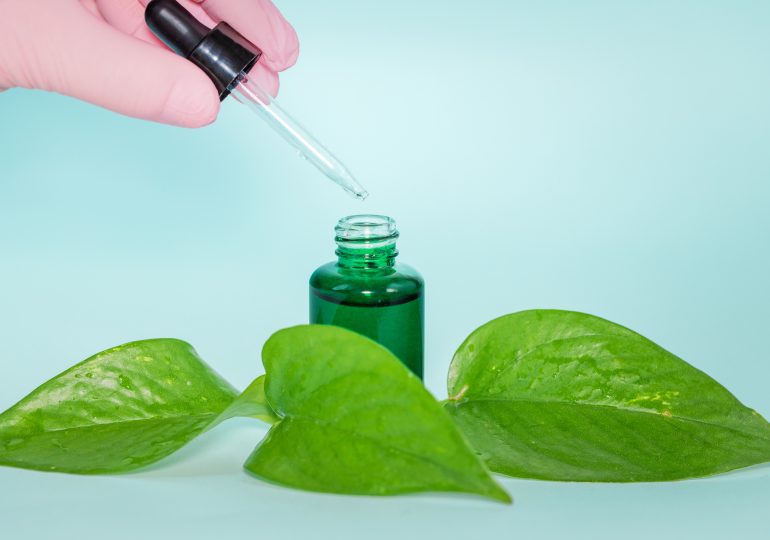Many people believe that natural ingredients are always preferable in beauty products. Natural must mean better, right?
But what if that’s not entirely true: Those natural essential oils you love in your skincare? More than 90% of a plant is typically discarded during the oil extraction process, with the remains left to decompose in landfills where they emit carbon dioxide and methane. That perfume with a whiff of rose? It takes 250,000 petals to create five milliliters of rose oil. The eye-catching red lipstick? Over 70,000 cochineal beetles are harvested and crushed to produce one pound of the red pigment, also known as carmine. (Alas, “animal-derived” products still continue to lurk in cosmetics.)
[time-brightcove not-tgx=”true”]
The “natural is better” thinking ignores fundamental truths about the toll of global ingredient harvesting, especially in the face of worsening climate change, loss of biodiversity, plant extinction, and damage to local communities. The harvesting of palm oil, for example, which is used in a number of beauty and skincare care products such as soap, shampoo, makeup, and hair care, is the cause of major deforestation and environmental devastation. According to the World Wildlife Fund, it is estimated that forests the size of 300 football fields are cleared every hour to make room for palm plantations, destroying the habitat of endangered species such as the orangutan, rhino, and tiger.
Earth cannot keep up with consumer demand for natural ingredients in beauty. In addition to requiring vast amounts of land, cultivation is hugely water and energy-intensive, necessitating pesticides and other agrochemicals. Then there’s the heavy carbon footprint associated with ingredient transportation from different parts of the world. Not to mention, with the rising global population, there is also a corresponding increased need to preserve land and natural resources for agriculture.
We need to find another way and biotechnology offers a solution. It reduces our dependence on unsustainable ingredient extraction and addresses our enduring love of naturals.
Unlike ingredient cultivation and harvesting, there is significantly less waste in a bioreactor. Biotechnology can create ingredients of 99% purity or more, according to certain studies, which is an even greater standard than organically-based beauty products. There is zero need for pesticides, far less carbon dioxide release, and dramatically reduced land and water usage. Nor is there batch or seasonal variability, ensuring peak ingredient quality every time, in contrast to crop-grown ingredients. Biotechnology also minimizes air-freighting of ingredients from around the world, resulting in greatly reduced carbon and greenhouse gas emissions. In fact, without biotechnology, beauty companies such as L’Oréal would not be able to set ambitious goals of achieving 95% bio-based ingredients by 2030. Biotechnology also eliminates the dependence on unsustainable, petrochemical-based ingredients derived from fossil fuels such as oil and gas.
In short, biotechnology mimics what nature has been doing for millions of years and translates it on an industrial scale, delivering all the benefits of nature—and a potentially endless supply of ingredients—while preserving global biodiversity.
Read More: How a Self-Taught Makeup Artist Built a Beauty Brand for Every Skin Tone
At this time, you might be asking yourself, “How does this process work in the real world?” The biomanufacturing process is akin to making beer, but instead of brewing beer, enzymes, and microbes are taught or “recoded” to make ingredients from sugar and other renewable sources. Biotech ingredients are nature-identical, genetic duplicates of the real thing.
Take Naringenin, a skincare ingredient derived from grapefruit and is known for its ability to reduce chronic low-level inflammation. To produce 1 kilogram of Naringenin requires 3,356 grapefruits, 0.37 acres, and 38,575 liters of water. Biotechnology makes the potency of this ingredient available without wasting land or water, thereby preserving natural resources for the sustainable development of food production.
Biotechnology is also transforming the “more is better” mindset that has governed our approach to cosmetic active ingredient concentrations. New biotech molecules are so potent that they can be used at exceedingly low concentrations, typically less than 0.5% compared to, say, 15 or 20% for natural ingredients such as vitamin C. Dosages in biotech beauty are akin to that of pharmaceuticals. Too much ibuprofen is very bad for you, but a highly targeted, defined, and scientifically-proven amount can be helpful. The same applies to cosmetic active ingredients. Biotechnology allows for great potency with minimal exposure to the harshness of active ingredients, which translates into no or minimal side effects and reduced skin sensitization.
Of course, there are challenges. Biotech is expensive when it comes to research, development, and manufacturing. Bio-active ingredients, the substances that are biologically active and have a direct effect on the body, will succeed in the immediate future because they deliver enhanced product efficacy and, in some cases, give a competitive advantage to brands. Non-active ingredients, namely ingredients that do not have a therapeutic effect (such as emollients, surfactants, and emulsifiers), cannot currently compete because they are not designed to target specific skin conditions. They are mainly delivery systems for active ingredients. Petroleum-based ingredients and products are also very cheap to make, and it will take years before the likes of bio-based palm oil can compete with the rock-bottom price of palm oil production in the chemical industry. But the change will come.
Not much has changed over the past 30 years in beauty, with ingredients such as cortisone, salicylic acid, and coal tar still being used to treat common conditions such as eczema, acne, and dandruff. Biotechnology promises to change all that, first in topical beauty, then nutrition and over-the-counter products, using personalized ingredients that work with our biology, or even alter it. There is so much to look forward to.
Leave a comment








